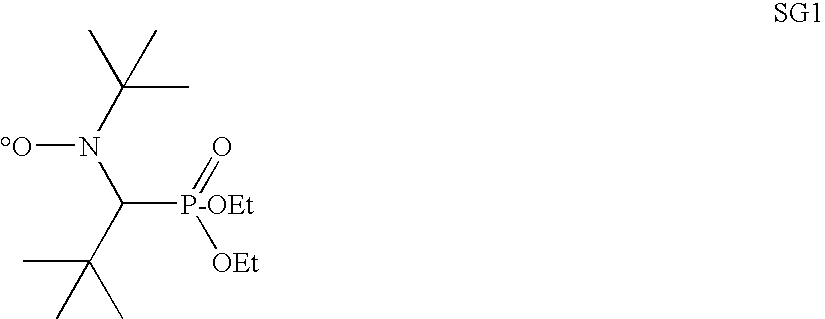Polymer encapsulation and/or binding
a polymer and encapsulation technology, applied in the field of functionalized and/or tailored polymers, can solve the problems of limited polymer composition and molecular weight ranges, slow polymerization kinetics, residual metallic byproducts, etc., and achieve enhanced functional agent encapsulation and control of agent release characteristics.
- Summary
- Abstract
- Description
- Claims
- Application Information
AI Technical Summary
Benefits of technology
Problems solved by technology
Method used
Image
Examples
example 1
[0084]A living first block terpolymer of poly(methylacrylate)=co-poly(polyethyleneglycol methacrylate)-co-poly(acrylic acid) was prepared using the alkoxyamine BlocBuilder® controller (iBA-DEPN). The polyethyleneglycol methacrylate had an average Mn of 475 g / mole and was supplied from Aldrich. 2.84 g of BlocBuilder® controller (7.4 mmol) was added to 40.7 g of methyl acrylate (0.473 mol) and 28.8 g of PEG methacrylate (60.5 mmol) and 4.5 g acrylic acid (62.5 mmol). The mixture was bubbled with nitrogen for 10 minutes before adding to a 250 mL glass reactor. The reactor was sealed, stirring started, and heated to 100° C. for 1 hour and then increased to 115° C. for 2 additional h's, at which point the methyl acrylate and acrylic acid were approximately 60% converted to polymer, and the PEG methacrylate was approximately 80% converted to polymer, corresponding to an Mn of approximately 6.4 kg / mol. The GPC gave a PDI of 1.2.
example 2
[0085]To form an amphiphilic diblock, 7.73 g of the polymer from example 1 was mixed with 70.9 g methyl methacrylate (0.709 mol). The mixture was bubbled with nitrogen for 10 minutes before adding to a 250 mL glass reactor. The reactor was sealed, stirring started, and heated to 107° C. for 80 minutes at which point the methyl methacrylate was approximately 54% converted to polymer, corresponding to an Mn of approximately 95.8 kg / mol. The GPC gave a PDI of 2.0.
example 3
[0086]To form a hydrophilic copolymer with a linking group L on the chain end, 0.77 g of BlocBuilder® controller (2.02 mmol) was added to 10.05 g of dimethylacrylamide (0.101 mol) and 30 g of ethyl acrylate (0.30 mol). The solution was placed into a vial with a magnetic stir bar and degassed. The vial was then heated to 115° C. and allowed to react for 180 minutes, until approximately 70% conversion of the ethyl acrylate was obtained and 75% conversion of the dimethylacrylamide, corresponding to an Mn of approximately 14.2 kg / mol. The GPC gave a PDI of 1.3.
PUM
| Property | Measurement | Unit |
|---|---|---|
| Amphiphilic | aaaaa | aaaaa |
| Composition | aaaaa | aaaaa |
| Hydrophilicity | aaaaa | aaaaa |
Abstract
Description
Claims
Application Information
 Login to View More
Login to View More - R&D
- Intellectual Property
- Life Sciences
- Materials
- Tech Scout
- Unparalleled Data Quality
- Higher Quality Content
- 60% Fewer Hallucinations
Browse by: Latest US Patents, China's latest patents, Technical Efficacy Thesaurus, Application Domain, Technology Topic, Popular Technical Reports.
© 2025 PatSnap. All rights reserved.Legal|Privacy policy|Modern Slavery Act Transparency Statement|Sitemap|About US| Contact US: help@patsnap.com



